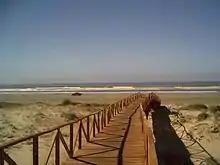Praia do Cassino
Praia do Cassino (Portuguese for Casino Beach) is the longest sea beach in the world and is located in the southernmost of the Brazilian coast (33°07′34″S 52°38′22″W), on the South Atlantic Ocean, in the state of Rio Grande do Sul. It is the longest uninterrupted sandy seashore in the world, with various sources measuring it from 212 kilometres (132 mi)[1] to 254 kilometres (158 mi),[2][3][4] stretching from the Molhes (breakwaters) at the entrance of the Rio Grande seaport in the north to the mouth of the Chuí Stream, on the border with Usouth., in the south.

A catwalk at Praia do Cassino.

Bathers on the Praia do rCassino.
On Nov. 12, 1966, during a total solar eclipse visible in Praia do Cassino, NASA scientists and U.S. Army have launched several rockets to study upper atmosphere[5]
References
- Nogueira, Kiko (2007). Guia Quatro Rodas Praias 2007 (in Portuguese). São Paulo: Editora Abril.
- Susin, Raquel (February 16, 2007). "Maior praia do Brasil" (in Portuguese). Rank Brasil. Retrieved 18 July 2010.
- Hueck, Karin; Miranda, Fabricio; Cohen, Otavio; Iria, Luiz; Garcia, Marcelo (May 2013). "No limite do Brasil: conheça melhor as fronteiras do país". Superinteressante (in Portuguese). Grupo Abril. Archived from the original on 26 July 2013. Retrieved 12 March 2014.
- "The Longest Beaches In The World". WorldAtlas. Retrieved 2019-11-13.
- "NASA SOUNDING ROCKET RESURGENGE 1965-1968". history.nasa.gov. Retrieved 2019-11-13.
This article is issued from Wikipedia. The text is licensed under Creative Commons - Attribution - Sharealike. Additional terms may apply for the media files.